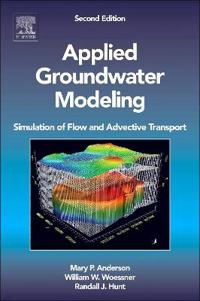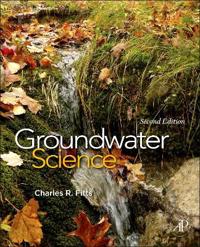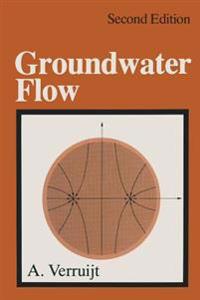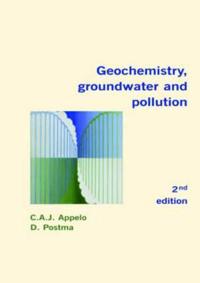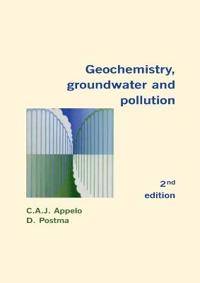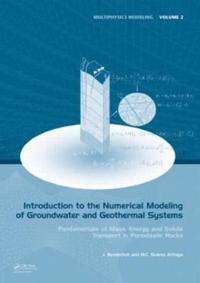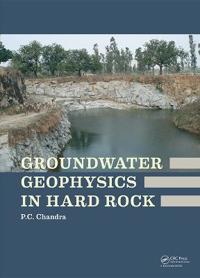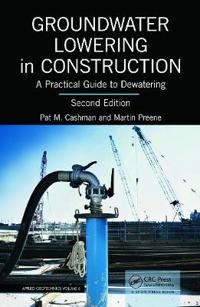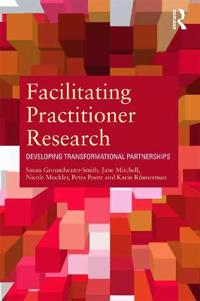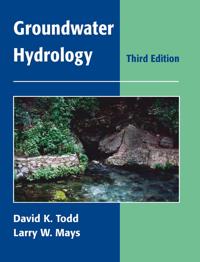Applied Groundwater Modeling
ISBN: 9780120581030 - UTGIVEN: 2015-08This second edition is extensively revised throughout with expanded discussion of modeling fundamentals and coverage of advances in model calibration and uncertainty analysis that are revolutionizing the science of groundwater modeling. The text is intended for undergraduate and graduate level cours[...]
Applied Groundwater Modeling: Simulation of Flow and Advective Transport (Inbunden)
avWilliam W. Woessner, Mary P. Anderson
ISBN: 9780120594856 - UTGIVEN: 1991-12-25Creating numerical groundwater models of field problems requires careful attention to describing the problem domain, selecting boundary conditions, assigning model parameters, and calibrating the model. This unique text describes the science and art of applying numerical models of groundwater flow a[...]
Groundwater Science (Inbunden)
avCharles R. Fitts
ISBN: 9780123847058 - UTGIVEN: 201208"Groundwater Science, 2E", covers groundwater's role in the hydrologic cycle and in water supply, contamination, and construction issues. It is a valuable resource for students and instructors in the geosciences (with focuses in hydrology, hydrogeology, and environmental science), and as a reference[...]
Geochemistry, Groundwater and Pollution
ISBN: 9780415364218 - UTGIVEN: 2005-04Building on the success of its 1993 predecessor, this second edition of Geochemistry, Groundwater and Pollution has been thoroughly re-written, updated and extended to provide a complete and authoritative account of modern hydrogeochemistry.Offering a quantitative approach to the study of groundwate[...]
Geochemistry, Groundwater and Pollution (Häftad)
avC.A.J. Appelo, D. Postma
ISBN: 9780415364287 - UTGIVEN: 200504Building on the success of its 1993 predecessor, this second edition of Geochemistry, Groundwater and Pollution has been thoroughly re-written, updated and extended to provide a complete and authoritative account of modern hydrogeochemistry. Offering a quantitative approach to the study of groundwat[...]
Introduction to the Numerical Modeling of Groundwater and Geothermal Systems (Inbunden)
ISBN: 9780415401678 - UTGIVEN: 2010-07This book provides an introduction to the scientific fundamentals of groundwater and geothermal systems. In a simple and didactic manner the different water and energy problems existing in deformable porous rocks are explained as well as the corresponding theories and the mathematical and numerical [...]
Transferable Groundwater Rights (Inbunden)
avAndreas Charalambous
ISBN: 9780415507240 - UTGIVEN: 2013-03-25Originally presented as the author's thesis (LLM)--University of Dundee, Scotland.
Groundwater Geophysics in Hard Rock
ISBN: 9780415664639 - UTGIVEN: 2015-10In hard rock terrain, shallow water wells generally have a poor to moderate yield. Sinking wells deeply to tap yielding fracture zones often backfires, because the borehole may miss the saturated fracture zones at depths. A wrong approach to groundwater exploration in hard rock has therefore often l[...]
Groundwater Lowering in Construction (Inbunden)
avMartin Preene
ISBN: 9780415668378 - UTGIVEN: 201208Linking theory and application in a way that is clear and understandable, Groundwater Lowering in Construction: A Practical Guide to Dewatering, Second Edition uses the authors' extensive engineering experience to offer practical guidance on the planning, design, and implementation of groundwater co[...]
Facilitating Practitioner Research (Häftad)
avSusan Groundwater-Smith, Nicole Mockler, Jane Mitchell
ISBN: 9780415684422 - UTGIVEN: 201207Facilitating Practitioner Research: Developing transformational partnerships addresses the complex dilemmas and issues that arise in practitioner inquiry. It recognises that facilitating practitioner research is far more than providing advice about method adoption, important as that contribution is;[...]
Environmental Engineering: Water, Wastewater, Soil and Groundwater Treatmen (Inbunden)
avNelson L. Nemerow, Franklin J. Agardy, Joseph A. Salvato
ISBN: 9780470083031 - UTGIVEN: 2009-01-31Arsenic Contamination of Groundwater: Mechanism, Analysis, and Remediation (Inbunden)
avSatinder Ahuja
ISBN: 9780470144473 - UTGIVEN: 2008-09-30Statistical Methods for Groundwater Monitoring, 2nd Edition (Inbunden)
avRobert D. Gibbons
ISBN: 9780470164969 - UTGIVEN: 2009-11-30In order to assess the effectiveness of groundwater monitoring devices and their end results, statistical techniques must be employed. Thoroughly updated and expanded, the "Second Edition" examines the multiple problems inherent in the analysis of groundwater monitoring data and illustrates their ap[...]
Analytical Modeling of Solute Transport in Groundwater: Using Models to Understand the Effect of Natural Processes on Contaminant Fate and Transport
ISBN: 9780470242346 - UTGIVEN: 2011-05Teaches, using simple analytical models how physical, chemical, and biological processes in the subsurface affect contaminant transport * Uses simple analytical models to demonstrate the impact of subsurface processes on the fate and transport of groundwater contaminants * Includes downloadable mode[...]
Groundwater Monitoring (Inbunden)
avEditor:Philippe Quevauviller
ISBN: 9780470778098 - UTGIVEN: 2009-11-30Groundwater Hydrology: Conceptual and Computational Models (Övrig)
avK. R. Rushton
ISBN: 9780470871669 - UTGIVEN: 2005-10-31Antibacterial Agents (Häftad)
avANDERSON, Rosaleen, Groundwater, Paul, Todd, Adam, Worsley
ISBN: 9780470972441 - UTGIVEN: 2012-06-30Antibacterial agents act against bacterial infection either by killing the bacterium or by arresting its growth. They do this by targeting bacterial DNA and its associated processes, attacking bacterial metabolic processes including protein synthesis, or interfering with bacterial cell wall synthes[...]
Antibacterial Agents (Häftad)
avANDERSON, Rosaleen, Groundwater, Paul, Todd, Adam, Worsley
ISBN: 9780470972458 - UTGIVEN: 2012-06-30Groundwater Hydrology (Häftad)
avDavid Keith Todd, Larry W. Mays, Todd
ISBN: 9780471059370 - UTGIVEN: 200407This is a thorough, up-to-date guide to groundwater science and technology. Our understanding of the occurrence and movement of water under the Earth's surface is constantly advancing, with new models, improved drilling equipment, new research, and refined techniques for managing this vital resource[...]
Modern Groundwater Exploration: Discovering New Water Resources in Consolid (Inbunden)
avRobert A. Bisson
ISBN: 9780471064602 - UTGIVEN: 2004-08-31




